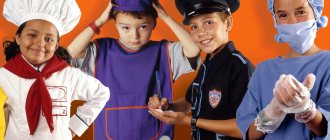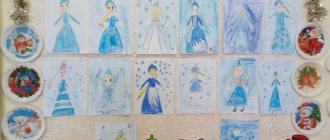Final lesson on FEMP in the younger group with presentation
Abstract of an open educational activity with the presentation “Travel with a Kolobok”
Author: The lesson and presentation were prepared by the teacher of MKDOU No. 233 Anna Anatolyevna Pashnina Description: This abstract using ICT is intended for educators working with children of primary and secondary groups. Integration of educational areas: “Cognition”, “Communication” Goal: To create conditions for the development of elementary mathematical concepts in a playful way, to develop the cognitive activity of children. Objectives: Educational:
- Teach children to conduct a dialogue with the teacher: listen and understand the question asked;
— To consolidate children’s knowledge about geometric shapes (circle, square, triangle), how they differ from each other; - Strengthen the ability to distinguish between the concepts: “as many - how many”, “none”, “one”, “many”; — Strengthen the ability to distinguish and name primary colors, compare objects by size, establish equality; — Exercise the ability to compare objects by color, size, shape. Developmental:
- Develop observation, attention, logical thinking, auditory and visual imagination;
— Develop in children the ability to think creatively; — Develop children’s speech; — Expand and activate the vocabulary. Educators:
- Foster a desire to help others;
— Cultivate an emotionally positive attitude towards mathematical games. Material: ICT (laptop, projector, audio speaker), presentation. Picture - a train, cars without wheels, Gyenish blocks, 4 cups, 4 spoons, square, round, triangular boxes (different colors), mushrooms, apples, a plate for pies, pictures of butterflies, flowers, toys.
Progress of the GCD
The teacher is part of the group together with the children. Educator: Guys, guests came to us today. Let's say hello to our guests. Good morning, smiling faces! Good morning to the sun and birds! Good morning, everyone on the planet Good morning, the children will say to everyone Good morning, our guests We wish good morning to all of us! Educator: Guys, do you like to travel? (Slide 1).
Do you like fairy tales?
This morning I met a hero from a fairy tale. He said that he really wants to meet you and take you on a fun trip. Do you want to meet him? Then guess the riddle: (Click) (slide 2)
Didn’t lie on the window, Rolled along the path... (gingerbread man).
(Click). Educator: That's right, this is a bun. And here he is. (Square shaped bun). Is there something wrong with him? Is this a bun? (No.) What shape is this bun? (square). What does he look like? (Cube) What shape is a real bun? (round) (Click) (Slide 2)
(a round shaped bun appears).
That's right, it's round. What does he look like? (ball, ball). Educator: Everything is clear, he decided to play a trick on us. Do you know a fairy tale about him? What happened to him at the end of the fairy tale? And today we will go on a journey to a new fairy tale about a little boy who loves mathematics. And to find out what we will go on our journey on, do you need to guess the riddle? The leaves of the crowns wave after him, And the carriages run behind him. It rushes merrily along the rails to the sound of wheels.... (Steam locomotive)
Colored carriages keep running along the rails.
And the round wheels go on and on and on. (Lay out a train with carriages, but without wheels.) Educator: Guys, look, what is this? (train)
Is there something wrong with him?
(The carriages have no wheels.) Educator: For some reason it has no wheels, did something happen? He wanted to take us to the forest, but on the way he probably lost his wheels. Let's help him find his wheels! Come to the table, there are different figures in the box. (Dyenish blocks)
The teacher takes a triangle from the box.
Take everything to yourself in one figure. What is the name of this figure? (triangle)
.
Let's trace the triangle with our finger. How many angles? (three)
.
Try rolling the triangle across the table. It turns out? (no,
why?
(corners get in the way)
.
Can triangles make wheels? (No)
.
Let's put the triangles in the box. How many triangles did you put in the box? (1)
and how old are you?
(1)
.
Everyone put one triangle, but how many figures were there in the box? (a lot of)
.
Let's take other figures (the teacher suggests taking squares)
.
Take one such figure each. What is the name of this figure? (square)
.
Does a square have corners? (yes)
How many angles?
(four)
Point them with your finger.
Let's count (one, two, three, four)
Show the sides.
Let's try to roll the squares, can we make wheels out of them? (no,
why?
(corners get in the way, don’t roll)
.
Put them in the box, you'll have to look for other wheels. Only these figures remain in the box (the teacher takes out the circles)
.
Take one such figure each. What is the name of this figure? (circle)
Can a circle roll?
(yes)
Is there anything stopping you?
(there are no corners, nothing interferes with rolling)
.
Do you think we can make train wheels out of circles? (yes)
Take one wheel at a time and let’s go and fix the train.
The train has been repaired. (Click) (Slide 3 along with the music “Bukashka the Steam Locomotive”).
Well, now let's go to the forest!
Cling to me, you will be my trailers. We hit the road. Educator: Look, here is the forest. (Click) (Slide 4)
What grows in the forest (trees).
What kind of trees? (High and low, different). What does the tree have? (Trunk and branches). How many trunks? (one), and what about branches? (A lot of). (Click) (Slide 5)
Animals live in the forest: wolf, hare, fox, dog, bear.
Is everything correct? Who's the odd one out? Why? (the dogs are domestic, and the rest are wild.) And in the forest, flowers still grow and butterflies fly. (On the board) Let's count how many butterflies there are (5), and how many flowers there are (4). Let's plant each butterfly on a flower. Is there enough space for all the butterflies? (No). What are fewer flowers or butterflies? (colors). What needs to be done so that there are equal numbers of butterflies and flowers? Educator: Guys, let's remember when the bun left his grandparents, who was the first person he met in the forest? (Click) (Slide 6)
(hare).
(An image of a hare appears) Educator: Look at the hare. What does a hare like to eat? (Carrot). For some reason he is sad. Educator: Bunny has prepared gifts for his friends and he needs to put them in boxes and send them out. So that each parcel contains as many items as the number on the box shows. Lay it out. Mushrooms in a red, round box for the squirrel. What is the number on the box (5). How many mushrooms will we put? (5). We put one at a time. Apples in a green square for a hedgehog. What is the number on the box (4). How many apples will we put? (4). We count (1,2,3,4,5). At the same time, I clarify how much they put in (4.5). How many parcels are empty? (none) how many unarranged apples and mushrooms (none) are left on the table? Educator: We helped the bunny. Who did the bun meet next? (Click) (Slide 7)
(Wolf).
(An image of a wolf appears.) And the wolf builds houses. He has a lot of work to do. He needs help. Let's help the wolf build houses like these (Click) (Slide
(children build houses from cubes). Which houses turned out to be the same or different. And how do they differ? (Color, shape and size).
Educator: We helped the wolf. Who did the bun meet next? ? (Click) (Slide 9)
(Bear). (An image of a bear appears). Bear says that while he was in the forest, Masha came to his house and made a mess of the toys. The bear really asks for help putting things in order. Let's help, Bears to put things in order? First you need to put a steam locomotive, then a tumbler, and then a spinning top and a pyramid. (Game “Which is on the count”, “What has changed?”).
Educator: Who did the bun meet next? (Click) (Slide 10)
(Fox) . We walked and walked and came to the little fox's little sister's house. The little fox is not at home now. She's waiting for guests. Let's give the little fox a surprise, let's help set the table for 3 guests. How many cups do you need? (3), and for the hostess herself? (one more .) How many in total? (4). How many spoons do you need? (also 4). Now there are cups and spoons? (Equal parts). So that she doesn’t eat the bun, you need to bake her pies.
Listen carefully which ones: not blue and not red (there are boxes with Dienesh blocks). Which ones? (yellow). Not round and not square (triangular.) Educator: Well, we helped the kolobok and visited his friends, it’s time for him to return to his grandparents (Click) (Slide 11)
(Say goodbye to the kolobok),
(click) (Slide 11).
(Kolobok disappears).
It's time for us to go to kindergarten. Cling to me, you will be my trailers. We are going to kindergarten. (Click) (Slide 12).
So we returned to kindergarten
(Click) (Slide 13). Reflection: What fairy tale did we visit and who did we meet? Who did we help? (name the animals)
What did we do?
(They counted, built houses from blocks, and determined pies for the fox.)
Did you enjoy the trip? What did you like most? Is it good to help?
Presentation on the topic: Traveling with a kolobok
We recommend watching:
Summary of GCD in mathematics in the younger group. The use of non-traditional forms of work in mathematics GCD for children of the junior group in mathematics “Bigger, smaller, smallest” Summary of a lesson in mathematics 2nd junior group “Geometric figures” Summary of a lesson on FEMP in the 2nd junior group. Journey to Geometry
Similar articles:
Summary of a mathematical game in the second junior group
Summary of the game in mathematics in the younger group
Mathematics lesson in the younger group “Parts of the day”
Summary of the lesson in mathematics “Number and figure 2”. Junior group
Summary of a mathematics lesson in the junior group “Coding geometric shapes”


